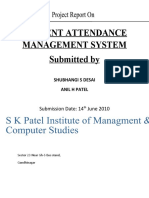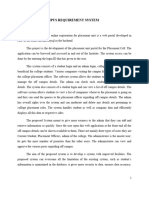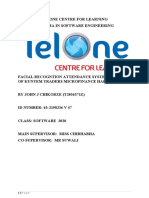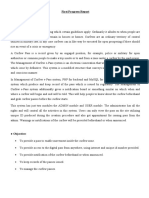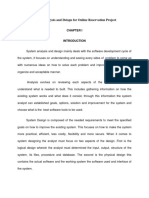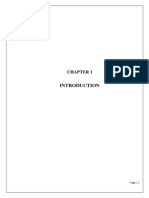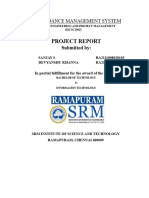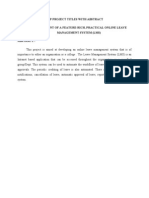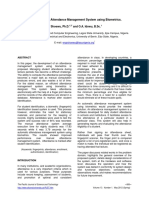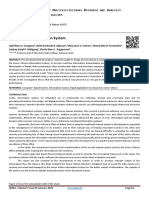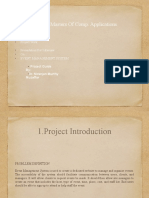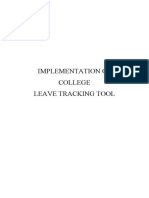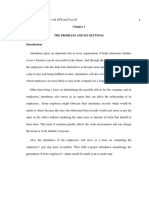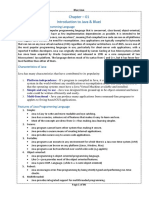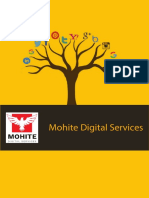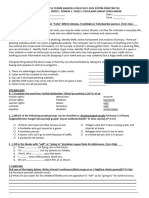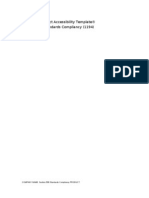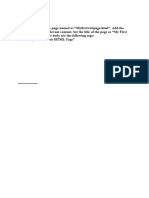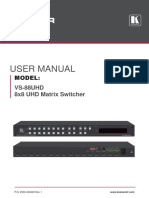Caps Docu
Caps Docu
Uploaded by
Dona MiCopyright:
Available Formats
Caps Docu
Caps Docu
Uploaded by
Dona MiOriginal Description:
Original Title
Copyright
Available Formats
Share this document
Did you find this document useful?
Is this content inappropriate?
Copyright:
Available Formats
Caps Docu
Caps Docu
Uploaded by
Dona MiCopyright:
Available Formats
Purpose and Description of the Project
The purpose of NORSU Event Attendance System is to overcome the
problems in taking, keeping and retrieving attendance manually. In this system
records are safe, secure and the attendance information of particular member or
event can be accessed easily and efficiently.
NORSU Event Attendance System is a service in which the admin can
create an event and get attendances. In this system the admin can monitor the
activeness of their member.
The study aims to develop, design and implement an automated system
based on the administrator's needs.
The overall objectives of the NORSU Event Attendance System assessment are
summarized below:
Objectives
1. To investigate the current situation and identify the problem
2. To analyze the use of the system in every organization
3. To design an attendance system that is useful for the organizations in
NORSU.
4. To develop a system that can help organizations in monitoring the
activeness of their members.
5. To implement a system this can make attendance more convenient and
faster.
Negros Oriental State University, Dumaguete City 2
Definition of Terms
To have a better understanding of the study, the following terms are
generally and technically defined:
NORSU Event Attendance System. A System that can be use in
getting attendance in an organization event.
Users. The personnel who are responsible for getting and inputting the
member’s name or ID number for their attendance.
Sociotechnical Systems Theory. A theory that is used as a basis in
designing and implementing the system.
V-model. A unique, linear development methodology used during a
software development life cycle (SDLC).
Scope and Limitations
The study covers the use of the present system. Automating it to easily
check the attendance of the members, staffs, faculty members, event organizers
and other attendee’s. To make it easier to take, keep and retrieve records in an
organizational event. The system is capable of maintaining the reliability of event
attendance record through the system. The system has two categories the admin
and the user side.
At the admin side:
Admin can create new events.
Gives activation code to the user to login in the system.
Negros Oriental State University, Dumaguete City 3
The admin is responsible for all the data that will be inputted in the
system.
At the user side:
The user needs to register first to get an activation code.
The user can select events;
The member can be able to take attendance by selecting the event
by pressing the in button and then member will press out after the
event.
The system has its limitations. In this system, it will only display a text-
field for the users to search/input their information to take attendance.
The limitations of the system are:
1. The system accessibility is limited within NORSU Environment.
2. The system will not log out automatically if the attendees forgot
to log out.
Significance of the Project
The study aims to provide accurate and more effective way of developing
an event attendance system in organizations of NORSU. Specifically, the results
of the study would benefit the following:
To the Administrator. It will help to organize the record and monitor
the member’s attendance in an organization.
Negros Oriental State University, Dumaguete City 4
To the Organizations of NORSU. The result of the study will provide
effective and efficient application for organizers that will be organizing the events.
To the Members. The study will benefit the members in an organization by
giving them the most efficient and effective way of getting their attendance at
different events which is not so time consuming.
To the Future Researchers. The study serves as a reference to the future
researcher that has the same goal in developing a system. Through this study,
future researchers will be able to get idea in developing an online system and be
able to add some features by referring to the Recommendation page
Negros Oriental State University, Dumaguete City 5
CHAPTER II
REVIEW OF RELATED LITERATURE/SYSTEMS
This chapter includes the ideas, finished thesis, generalize or conclusion,
Methodologies and others. This chapter includes all familiarizing information that
is relevant and similar to the present study.
This study aims to have a NORSU Event Attendance System; there are some
information that may be helpful to the researchers. It also shows section of the
discussion of related literature and studies gathered from different sources to a
better understanding about Attendance System.
Related Literature
According to Sahar Hassan (2015) over the years the manual attendance
management has been carried across most of educational institutions. To
overcome the problems of manual attendance, Sahar Hassan developed “web
based attendance Management System”. Attendance Management System is
based on web server, which can be implemented on any computer. In This
application, PHP is server side language, MySQL and PHP is used as back-end
design and HTML, CSS and JavaScript are used as front-end tools. The system
communicates with database residing on a remote server. It calculates
automatically, the attendance percentage of students without any manual paper-
based work. The system facilitates the end users with interactive design and
automated processing of attendance management.
Foreign Literature: According to Primer (2005), for many businesses
Negros Oriental State University, Dumaguete City 6
automating the collecting of employee attendance data when employees begin
their shifts is still a manual process. Even business that has automated or
computerized processes such as scheduling, inventory, purchasing, general
ledger and payroll processing still use manual methods such as time cards or
attendance sheets to collect time and attendance data.
Ramon Faloran (2005) wrote in the article “The Computer Edge of the
New Employment and Opportunities “in the Philippine Daily Inquirer. He stated
that computer gives you a different feeling about what is happening in the
company. Business will be highly competitive and innovative because the
computer provides instant information.
Related Studies
John Aquilan made a comparable thesis entitled “Automation of Time
attendance system” in 2004, it stated that the automation of the time
attendance records, time in and time out of every employee using barcode
system. It tends to eliminate the manual recording system of time and
attendance and also include salary computation of each employee based on
the time and attendance reports.
Local Study:
Mendrez (2007) made a similar study for Vision Designer Inc. It has an
identification machine aimed at verifying a person entering through the swiping
of identification cards. After entering their given code number, the identification
cards are swiped in the machines card reader to trigger the verification. If access
Negros Oriental State University, Dumaguete City 7
granted, the micro switch will then automatically unlock to allow enter. This will
help a lot in monitoring attendances accurately and more precise. A group of
computer engineers in Rebisco Biscuits Corporation proposed a thesis report for
what is the same Innodata Corps is implementing right now a computerized daily
time record as an alternative for Bundy clock. The means of getting inside the
company premises is by swiping cards into a machine that reads every record of
each employee then monitor and displays the time a particular employee logs in
and out. In the 2005 annual report of the Forest Products Research and
Development Institute under the Department of Science Forest Products
Research and Development Institute was designed to facilitate the Institute's
data entry, processing, computation and maintenance of employee time and
attendance transactions. The system allows employees to log in/out as the swipe
their IDs through a barcode reader attached to a computer terminal. The
processing forms include those for legal holidays, travel order, tardiness, under
time, vacation and sick leave. Pertinent Report forms have been designed for
easier access to all these data.”
FOREIGN STUDY
Columbia State Community College (2006) uses computer identification
account (Log In Name and Password) for access to the institutions computer
usage logs occurs electrically through the individual users log in/out process.
Users are also informed that they are responsible for any computer file’s,
database and/or internet sites that are accessed through their computer
Negros Oriental State University, Dumaguete City 8
identification account, not withstanding their failure to adhere to the log in/out
process, on their voluntary publication of their account information to others.
My Time Force (2006), Time Force is the key to proficient and successful
time tracking and management in your workplace. It is a software-based time
and attendance system that allows the user to collect and organize employee
time data simply and accurately. You can use Time Force to:
• Easily and efficiently track your employee time.
• Manage your time & attendance data and employee profiles.
• Eliminate buddy punching.
• Make employee scheduling a breeze.
• Reduce the headaches and time associated with payroll.
Best of all, Time Force can quickly pay for itself in time savings, reduction of
time theft and elimination of payroll errors. Time Force is the manifestation of
10years of experience, customer feedback, and research and development in the
time and attendance market. Over 35,000 businesses use Time Force
Negros Oriental State University, Dumaguete City 9
CHAPTER III
TECHNICAL BACKGROUND
This chapter offers a brief discussion in developing the NORSU Calendar
System in terms of technicalities and also it represents theoretical and
conceptual framework.
Theoretical Framework
This section gives an overview of the theories as part of the strategies and
shows the theory which helps to broaden the idea of how the system works.
Sociotechnical Systems Theory
Sociotechnical systems (STS) in organizational development is an approach
to complex organizational work design that recognizes the interaction between
people and technology in workplaces. The term also refers to the interaction
between society's complex infrastructures and human behavior. In this sense,
society itself, and most of its substructures, are complex sociotechnical systems.
The term sociotechnical systems was coined by Eric Trist, Ken Bamforth and Fred
Emery, in the World War II era, based on their work with workers in English coal
mines at the Tavistock Institute in London.
A Sociotechnical system pertains to theory regarding the social aspects of
people and society and technical aspects of organizational structure and
processes. Here, technical does not necessarily imply material technology. The
focus is on procedures and related knowledge, i.e. it refers to the ancient Greek
Negros Oriental State University, Dumaguete City 10
term logos. "Technical" is a term used to refer to structure and a broader sense
of technicalities. Sociotechnical refers to the interrelatedness of social and
technical aspects of an organization or the society as a whole. Sociotechnical
theory therefore is about joint optimization, with a shared emphasis on
achievement of both excellence in technical performance and quality in people's
work lives. Sociotechnical theory, as distinct from sociotechnical systems,
proposes a number of different ways of achieving joint optimization. They are
usually based on designing different kinds of organization, ones in which the
relationships between socio and technical elements lead to the emergence of
productivity and wellbeing.
Technology Acceptance Model
Based on the theory of reasoned Action, Davis ( 1986 ) developed the
Technology Acceptance Model which deals more specifically with the prediction
of the acceptability of an information system. The purpose of this model is to
predict the acceptability of a tool and to identify the modifications which must be
brought to the system in order to make it acceptable to users. This model
suggests that the acceptability of an information system is determined by two
main factors: perceived usefulness and perceived ease of use.
Perceived usefulness – This was defined by Fred Davis as "the degree
to which a person believes that using a particular system would
enhance his or her job performance".
Negros Oriental State University, Dumaguete City 11
Perceived ease-of-use – Davis defined this as "the degree to which a
person believes that using a particular system would be free from
effort" (Davis 1989).
(Sociotechnical
(Sociotechnical Theory
Theory Technology
Technology Acceptance
Acceptance
Eric
Eric Trist
Trist and
and Ken
Ken Model
Model
Bamforth,
Bamforth, 1951)
1951) ((
Davis,
Davis, Bagozzi
Bagozzi &
& Warsh
Warsh
aw
aw 1989
1989
))
NORSU
NORSU EVENT
EVENT
ATTENDANCE
ATTENDANCE
SYSTEM
SYSTEM
Figure 1. Theoretical Framework of the Study
Figure 1 shows the theory that has been used to develop the system.
Socio-technical theory has at its core the idea that the design and performance
of any organizational system can only be understood and improved if both ‘social’
and ‘technical’ aspects are brought together and treated as interdependent parts
of a complex system. While Technology Acceptance suggests that when users
are presented with a new technology, a number of factors influence their
decision about how and when they will use it. Researchers used these theories
as a basis in creating and implementing NORSU Event Attendance System.
Negros Oriental State University, Dumaguete City 12
Conceptual Framework of the Study
The study was based on the concept of effective analysis, designing,
prototyping and development that would lead to successful implementation of
NORSU Event Attendance System for more reliable and better interface. The V-
Model is comprised of stages that developers use when developing the system. It
is a major drawback of waterfall model. The developer has to finish one stage
before going to the next one. V-Model provides means of testing of software at
each stage in reverse manner.
At every stage, test plans and test cases are created to verify and validate
the product according to the requirement of that stage. For example, in
requirement gathering stage the test team prepares all the test cases in
correspondence to the requirements. Later, when the product is developed and
is ready for testing, test cases of this stage verify the software against its validity
towards requirements at this stage. This makes both verification and validation
go in parallel. This model is also known as verification and validation model.
Figure 2 . Conceptual Framework of the Study
Negros Oriental State University, Dumaguete City 13
The phase 1 in V-model is Requirement Modeling; the researchers gathered
requirements based on observation, interviewing and survey. The phase 2 is the
System Analysis where the researchers found a problem which is the manual
taking of attendance in an event that is more time consuming, prone to errors
and more chances in losing the records. Phase 3 Software Design utilizing
feedback and user requirement documents created during the requirements
phase. It will outline all technical components. Phase 4 the Module Design, it
consists of all the low level design for the system. Phase 5 Coding, In this stage
the actual coding and implementation occur. Phase 6 Unit testing , in this phase
eliminate the vast majority of potential bugs and issues in the system. Phase 7
Integration system, the phase where ensures that the system functions across all
components and third party integrations. Phase 8 is the System testing which is
largely focusing on performance and regression testing. Phase 9 Acceptance
Testing is the process of implementing all tests created during the initial
requirements phase and ensures the system is functional in a live environment,
ready for deployment.
Negros Oriental State University, Dumaguete City 14
CHAPTER IV
METHODOLOGY, RESULTS AND DESCRIPTIONS
The purpose of this chapter is to show the methods used to collect data and
the statistical treatment, and/or mechanic of analysis of the study.
Research Methodologies
This section describes and explains the various research related activities
and components. This includes research method, research respondents, research
environment, research design, research instrument, research procedures, and
the statistical treatment of data.
Research Method
The study utilized the V-Model to summarize the main steps to be taken in
conjunction with the corresponding deliverables within computerized system
validation framework.
The entire course of the study aims to analyze how event attendance
used for the said system, to design and develop a functional system NORSU
Event Attendance and to test ad implement a reliable and efficient NORSU Event
Attendance System.
Research Respondents
The respondents of the study are the NORSU Organizations that will host
an event in Negros Oriental State University.
Research Environment
The study will be conducted at Negros Oriental State University, Dumaguete
Negros Oriental State University, Dumaguete City 15
City .
Research Design
The researcher emphasized the use of the V-Model. It provides means of
testing of software at each stage in reverse manner. At every stage, test plans
and test cases are created to verify and validate the product according to the
requirement of that stage. For example, in requirement gathering stage the test
team prepares all the test cases in correspondence to the requirements. Later,
when the product is developed and is ready for testing, test cases of this stage
verify the software against its validity towards requirements at this stage. This
makes both verification and validation go in parallel. This model is also known as
verification and validation model.
Requirement Specifications
The section describes the software system to be developed. It lays out
functional and non-functional requirements and may include a set of use cases
that describe user interactions that the software must provide.
Technical Feasibility
It is an assessment that focused on gaining an understanding of the
present technical resources of the organization and their applicability to the
expected needs of the proposed project. It is an evaluation of the hardware and
software and how it meets the need of the proposed system.
The Negros Oriental State University Event Attendance System had
envisioned providing organizations of the university to have an efficient way in
Negros Oriental State University, Dumaguete City 16
terms of taking, keeping and retrieving attendance system.
The technologies that are used to are the following:
Table 1: Software Specifications of the Proposed System
Software Minimum Recommended
Sublime Sublime X
Table 2: Hardware Specifications of the proposed System
Type of Application Hardware Specifications
Processor: at least Pentium 4
processors or later versions.
Web Based
Application RAM: at least 512mb of memory.
HDD: at least 40MB of hard drive
space.
Compatibility Checking
Checking compatibility between programs consists of two goals, which we
address in two steps. First, we infer the formats each program operates upon.
Second, we check compatibility.
Familiarity with System
Negros Oriental State University, Dumaguete City 17
Since the system is web-based and it is using the basic function in the
database which is the CRUD, creating, retrieving, updating, deleting,
we, the developers of the system are very familiar to it, on how will it
function.
Familiarity with Technology
Personal Computers, laptops, and desktops are mostly the type of
technology that will be used which we are able to operate.
Relevance of the Technologies
XAMP – Developers will use this as development tool, to allow website designers
and programmers to test their work on their own computer without any access
to internet.
MySQL – Pronounced either “My S-Q-L” or “My Sequel,” is an open source
relational database management system. It is based on the structure query
language(SQL), which is used for adding, removing, and modifying information in
the database. Standard SQL commands, such as ADD, DROP, INSERT, and
UPDATE can be used with MySQL. MySQL can be used for a variety of
applications, but is most commonly found on Web servers. A website that uses
MySQL may include Web Pages that access information from a database. These
pages are often referred to as “dynamic,” meaning the content of each page is
generated from a database as the page loads. Websites that use dynamic Web
pages are often referred to as database-driven websites. MySQL will use by the
researcher because it is one of the database that is compatible with the
Negros Oriental State University, Dumaguete City 18
development of the system.
HTML – This is the language that Webpages are written in. If you want to
create really great Webpages then you will need to learn this. As far as computer
language go, this is the easiest to learn. You can create a webpage without it
using a web page editing program but the program will still use the HTML to
create the page.
CSS – Cascading style sheets are used to format the layout or webpages. They
can be used to define text styles, table sizes, and other aspects of webpages that
previously could only be defined in a page’s HTML.
Javascript – Like java, this is a programming language designed by Suri
Microsystems, in conjunction with the Netscape that can be integrated into
standard HTML pages. While Javascript is based on the Java syntax, it is a
scripting language and therefore cannot be used to create stand-alone programs.
Instead, it is used mainly to create dynamic, interactive webpages.
PHP – A server-side scripting language designed primarily for web development
but also used as a general-purpose programming language.
Computer – Used to run the proposed system with processor at least Pentium 4
or later versions. RAM at least 512MB of memory. HD at least 40MB of hard drive
space.
Schedule Feasibility
Negros Oriental State University, Dumaguete City 19
This shows the schedule of activities the researchers must undergo to be
able to achieve the NORSU Event Attendance System. It includes the phases and
the activities under each phase. Each activity has corresponding time duration
and presented in weeks.
Figure 3. Gantt chart
Phase 1, which is planning of the system, took 19 days to complete. This
is from June 11 to June 29, 2018. Phase 1 can be broken down to three tasks:
composed proposed subject identified requirement process and submitted
proposed project. Phase 2 of the project is analysis of the system, it includes the
analysis of what are the functions to be used to the system as well as the flow of
the system, it took 21 days which from July 2 to July 22, 2018 . Phase 3 of the
Negros Oriental State University, Dumaguete City 20
project which is design took 44 days to complete; this is from July 23 to August
31, 2018. Phase 3 can be broken down to 2 tasks: elaborate system design and
approved proposed subject. Phase 4 of the system which is development took
140 days. This is from September 3 to January 20, 2019. Phase 4 can be broken
down to 3 tasks: development of the system, gathered data and information and
documentation. Phase 5 of the project which is integration and testing took 21
days to complete. This is from January 21 to February 10, 2019. Phase 5 can be
broken down to 2 tasks: checked the developed project and coded proposed
project. Phase 6 which is maintenance took 14 days. This is from February 11 to
February 24, 2019.
Economic Feasibility
The economic feasibility demonstrates the net benefit of a proposed
project for accepting or disbursing electronic funds/benefits, taking into
consideration the benefits and costs to the agency, other state agencies, and the
general public as a whole.
Budgetary Estimate
The budgetary estimate is the approximation of the cost of the project.
The budgetary estimate is not accurate enough to provide a basis. It represents
only the budget makers understanding of the scope and expense of what needs
to be done.
Negros Oriental State University, Dumaguete City 21
Table 3.Budgetary Estimate of NORSU Event Attendance System
Quantity Item Cost
1
Acer Laptop Php 24,000.00
- Intel core i5
- Windows 10
1 Pocket wifi/Internet Connection Php 1,900.00
Total: Php 25,900.00
The table above is the estimated budget cost for the NORSU Event
Attendance System. The project needs laptop which the estimated cost is Php
24,000 to use in making and implementing the system. It also needs internet
connection or pocket wifi which the estimated cost is Php 1,900. The project’s
total cost would be Php 25,900.
Requirement Modeling
Requirement modeling sets the Input, Process and Output flow of the
System. Requirements are a pragmatic description of the system to be built.
They should focus on the problem that this system solves and description of
system. Focus on what users expect to do with the system and discuss the scope
of your system or particular releases of the system. The requirement modeling
specifies the functional requirement of the system.
Negros Oriental State University, Dumaguete City 22
Input. The member will log in then select event then press the in to take the
attendance. On the other hand, organizer also have the option to assign a
personnel to take attendance to the members
Process. The NORSU Event Attendance System. The admin will be the one
who can create events, manage all the information and give activation code to
every members.
Output. The output of NORSU Event Attendance System is that it can record
the time in or out of each member during an event and will be able to easily
keep the attendance records for retrieving and can print out the attendance
records.
Performance. The system is efficient and very reliable for the organizations
in NORSU that will conduct an event.
Control. Only those staffs or administrators in an organization can view
those members that are present or absent in every events.
Data and Process Modeling
Negros Oriental State University, Dumaguete City 23
Figure 4. Data Flow Diagram
The figure 4 shows the data flow diagram of NORSU Event Attendance
System in which the user side will select event then look/search for his/her name
then log in to take the attendance. Once the user will log in, automatically it
records the date and time he/she log in. In the Admin side, he can add student
that is not yet on the list or edit the student information. Admin can also view
the events. In addition, he can also view members’ attendance in a specific
event.
Negros Oriental State University, Dumaguete City 24
Object Modeling
Figure 5. Use Case Diagram
Object modeling is an approach where the system shows the model and
the design. The objects describe the process of the NORSU Event Attendance
System which represented by the Use Case diagram. It shows the functionalities
of both admin and end users. Users are usually the members that can access the
website while only the in-charge personnel who is the admin controls the system.
Negros Oriental State University, Dumaguete City 25
Requirements Documentation
Design of Software, Systems, Products, and/or Processes
Output and User-interface Design
This section shows the interfaces wherein the users will interact with the
system and input data in order to command the system.
Figure 6. User’s Login Form
. The primary task of the user is to login his/her account but if the user
doesn’t have an account he/she must sign-up for an account.
Negros Oriental State University, Dumaguete City 26
Figure 7. Registration Form
This figure show the registration form which is needed for the member
who doesn’t registered yet. They need to fill up the form to get an activation
code to login.
Figure 8. Create Attendance
The figure above shows the admin side which is he/she can view and
Negros Oriental State University, Dumaguete City 27
create events.
Figure 9. Event Attendance
This figure shows the Event Attendance page, the admin can view all the
attendees’ attendance.
Figure 10. Members
Figure 10 shows that the admin can view all members and can add members.
Negros Oriental State University, Dumaguete City 28
Figure 11. Event List
Figure 11 shows the event list where it can view all the events and
members.
Figure 12. Administrator Option
Negros Oriental State University, Dumaguete City 29
Figure 12 shows the administrator module where it can activate members
as well as manage the administrator levels.
Data Design
This section will be data design which results in fewer complexes, modular
and efficient program structure. The information domain model developed during
analysis phase is transformed into data structures needed for implementing the
software.
Table 4. Data Dictionary
Field Name Data Type Data Format Example
ID Number Number 20140001
Firstname Text Dona Mae
Middlename Text Quibedo
Lastname Text Jamito
Username Text Dona
Event Name Text CSIT Forum
Event Venue Text YY-MM-DD NORSU GYM
Time Date/Time 2019-01- 27
Time 2:05:10
System Architecture
In system architecture presents the components as it illustrates the
network design of the system and its interaction between the device and the
server.
Negros Oriental State University, Dumaguete City 30
Figure 13. System Architecture
Figure 10 shows the System Architecture of NORSU Event Attendance
System on both administrator and end-user side. All the data will automatically
stored in the database of the system.
Development and Testing
This phase presents the specifications needed in the development of the
system which includes software, hardware and the programming environment.
Software Specification
To develop the system, XAMP server was used as a temporary server/local
host for testing the project. Sublime text is the editor in encoding and debugging
our website which we used HTML, PHP, CSS, SQL, Javascript and bootstrap. For
browsing the system, we used Mozilla Firefox and Google Chrome.
Hardware Specification
It requires PC or Laptop at least Pentium 4 processors or later, ram at
least 512mb of memory and HDD at least 40MB of hard drive space.
Negros Oriental State University, Dumaguete City 31
Programming Environment
This section describes what functions the sytem will have and how these
functions will work.
Front End
CSS – used to define styles or your web pages, including the
design, layout and variations in display for different devices and screen size.
HTML – This software will be used to develop markup languages
of the site. This will provide the interface of our website.
JavaScript – It provides user interface enhancements for every
dynamic website. This is used to create scripts such as alert boxes, which
provide users instructions.
Back End
PHP - Mainly used for design server-side applications and used to
add functionality to websites that HTML alone can’t achieved.
Test Plan
The application will be tested according to the functionalities and expected
output. The testing will be done by the members in the organization of the
university. Feedback will be taken from the respondents and any recommended
changes will be applied.
The system will also be tested by IT experts in order for them to see how
the system works and be able to give feedbacks and suggestions.
Negros Oriental State University, Dumaguete City 32
Unit Testing
Unit testing was conducted to ensure that the functionality of the NORSU
Event Attendance System is working properly according to the specifications and
expected output of the modules. Module by module each unit will be tested to
confirm that each unit of the proposed unit will achieve its expected result.
Integration Testing
Integration testing will be the next step after the unit testing. In
integration testing, each module will be integrated to function as one to perform
its expected output according to the specification of each module. And through
outputs of each module, it will be used to communicate with other modules so
that it will produce the expected output.
The purpose of integration testing in NORSU Event Attendance System is
to verify functional, performance and reliability requirements placed on the major
design items. These design items are exercised through their interfaces using
client testing, success and error cases being simulated via appropriate parameter
and data inputs.
User Acceptance
In user acceptance, usually the end users who will use the applications
test the application for its efficiency and reliability before accepting the
application.
Negros Oriental State University, Dumaguete City 33
Results and Observations
The flow of the system will undergo an automated manner which means
members will just select an event then log in to take attendance. The proposed
system will be generating the data to be stored, retrieved, accessed and
modified to attain an efficient and reliable attendance system. The administrator
can easily view events and members if he/she is present or absent in the specific
event. All the data and information inputted in the system will be stored in the
system’s database. With this, the system will ensure its reliability and efficiency
in terms of attendance records.
Table 5. Weighted Mean for Usability as rated by IT Experts
Sub-Criterion Mean Perceived Usability
Understandability 3.33 Very Usable
Documentation 3.33 Very Usable
Buildability 3.36 Very Usable
Installability 3.36 Very Usable
Learnablity 4 Very Usable
Grand Mean 3.6 Very Usable
The table above presents the Software Usability of NORSU Event
Attendance System as rated by the 3 IT Experts. The result revealed that the
NORSU Event Attendance System was very usable with a grand mean of 3.6. It
implies that it follows the usability checklist, guidelines and standards based on
the usability elements. NORSU Event Attendance System is easy to understand
based on the result as rated by the IT Experts.
Overall, the NORSU Event Attendance System is very usable because all
Negros Oriental State University, Dumaguete City 34
the results of the elements based on the standards and guidelines are
remarkably commendable.
Table 6. Weighted Mean for Maintainability/Sustainability as rated by IT Experts
Sub-Criterion Mean Perceived Maintainability and
Usability
Identity 3 Maintainable
Accessibility 3.33 Very Maintainable
Testability 3.66 Very Maintainable
Portability 3.66 Very Maintainable
Supportability 3 Maintainable
Analyzability 3 Maintainable
Changeability 3.66 Very Maintainable
Interoperability 3.66 Very Maintainable
Total 3.37 Very Maintainable
Legend: 1.00 – 1.75 Not Maintainable
1.76 – 2.50 Moderately Maintainable
2.51 – 3.25 Maintainable
3.26 – 4.00 Very Maintainable
The table above shows the Software’s Maintainability and Sustainability
has a grand mean of 3.37 which means that NORSU Event System is very
sustainable and very maintainable based on what the IT Experts have perceived
during the system testing and evaluation. The result suggests that maintainable
software is easy to extend and fix which encourages the software’s used.
Collectively, this means that NORSU Event Attendance System has
evidence of the current support and development.
Table 7. Perceived Usefulness of NORSU Event Attendance System as rated by the
Respondents as the User of the System
Perceived Usefulness Weighted Verbal
Mean Description
Negros Oriental State University, Dumaguete City 35
Using the system it will 3.9 Very Useful
make easier to take
attendance
Using the system will 3.8 Very Useful
make easier to keep
attendance
Using the system will 3.7 Very Useful
make easier in retrieving
attendance records
Using the system can 3.3 Very Useful
provide more efficient
result
Grand Weighted Mean 3.68 Very Useful
Legend: 1.00 – 1.75 Not Useful
1.76 – 2.50 Partially Useful
2.51 – 3.25 Useful
3.26 – 4.00 Very Useful
This study validates new scales for two specific variables, perceived
usefulness and perceived ease-of-use which are believed to be the fundamental
determinants of user acceptance of the NORSU Event Attendance System.
The Table above shows the Perceived Usefulness of the NORSU Event
Attendance System as rated by 13 respondents as the user of the system. The
result revealed that the system is “very useful” with grand weighted mean of
3.675. In the same direction, the result indicates that using NORSU Event
Attendance System helps the members, staffs and organizers in taking, keeping
and retrieving attendance records.
Table 8. Perceived Eased-of-Used of NORSU Event Attendance System as rated by the
Respondents as the User of the System
Perceived Eased-of-Used Weighted Verbal Description
Mean
Learning to operate the system would be 3.9 Very Useful
easy for me.
My interaction to the system would be clear 3.4 Very Useful
Negros Oriental State University, Dumaguete City 36
and understandable
I would find the system flexible to interact 3.8 Very Useful
with
I would find it easy to get the system to do 3.5 Very Useful
what I want to do.
I would find the system easy to use. 3.6 Very Useful
Grand Mean 3.64 Very Useful
Legend: 1.00 – 1.75 Not Useful
1.76 – 2.50 Partially Useful
2.51 – 3.25 Useful
3.26 – 4.00 Very Useful
The result suggested that the NORSU Event Attendance System is easy to
operate, easy to use and flexible to interact with. It is efficient and eases the
problems of the students by automating and improving the system. The result
revealed that the system is “very useful” with grand mean of 3.64. The result
indicates that using NORSU Event Attendance System is very useful in taking,
keeping and retrieving attendance records in an organization.
Negros Oriental State University, Dumaguete City 37
CHAPTER V
RECOMMENDATIONS
Findings
Recording attendance manually is the most common method used by
organizations in which;
1. It is time – consuming
- taking attendance
- retrieving attendance
2. It is space – consuming
3. It can let members signing in for friends without his/her
presence
4. It can lead to disorganization of attendees
5. You need to look for a good location where to place attendance
sheet which it is a hassle
5. There will be more possibility that it will be lost (forgot where was
placed) (forgot who brought the attendance sheet)
Conclusions
Based on the information gathered, observations, thoughts and ideas, the
researchers were able to come up with the conclusions regarding the system,
NORSU Event Attendance System.
The following are the conclusions of the study:
Negros Oriental State University, Dumaguete City
By using the NORSU Event Attendances System, it can lessen the time
and much easier in taking attendance as well as retrieving the
attendance records in every organizational event in NORSU.
In terms of keeping the attendance records, it will not be a hassle
since the system will automatically record the attendances of the
members of a specific event.
Recommendation
The researchers recommend that the organizations in Negros Oriental
State University should use the NORSU Event Attendance System to make it
more efficient in terms of taking, keeping and retrieving attendance records and
it is also reliable enough.
Negros Oriental State University, Dumaguete City
You might also like
- Attendance Management SystemDocument16 pagesAttendance Management SystemMrunal Shirpurwar50% (2)
- Chapter 1 Document Tracking SystemDocument6 pagesChapter 1 Document Tracking SystemRey Allen TenosoNo ratings yet
- Attendance Management System: Monica.C, Nithya.R, Prarthana.M, Sonika.S.V, Dr.M.RamakrishnaDocument5 pagesAttendance Management System: Monica.C, Nithya.R, Prarthana.M, Sonika.S.V, Dr.M.RamakrishnaAsk AskNo ratings yet
- Student Attendance Management System - ERDIAGRAMDocument21 pagesStudent Attendance Management System - ERDIAGRAMShivangi Thakker73% (11)
- POS ThesisDocument39 pagesPOS ThesisAinz Ooal GownNo ratings yet
- Visitors Log Monitoring System For BJMP Capstone ProjectDocument8 pagesVisitors Log Monitoring System For BJMP Capstone ProjectPlacid Ity50% (4)
- Attendance Monitoring System Using Facial RecognitionDocument10 pagesAttendance Monitoring System Using Facial RecognitionMary Joy Solancho100% (2)
- Attendance Monitoring System of Employee Using QR Code: 1.2 Purpose and DescriptionDocument10 pagesAttendance Monitoring System of Employee Using QR Code: 1.2 Purpose and DescriptionRowena Entendez EscolNo ratings yet
- Automated Fingerprint Attendance System Using Biometrics ReportDocument8 pagesAutomated Fingerprint Attendance System Using Biometrics ReportSam Maosa100% (1)
- Attendance Monitoring System CHAPTER I TDocument8 pagesAttendance Monitoring System CHAPTER I TAldwin VillanuevaNo ratings yet
- Online Attendance SystemDocument4 pagesOnline Attendance SystemshitalNo ratings yet
- Employees-Attendance-System-via-Fingerprint: BCS Final Year Project/Thesis Proposal ForDocument7 pagesEmployees-Attendance-System-via-Fingerprint: BCS Final Year Project/Thesis Proposal Fornek mohammad abbasiNo ratings yet
- Employees-Attendance-System-via-Fingerprint: BCS Final Year Project/Thesis Proposal ForDocument7 pagesEmployees-Attendance-System-via-Fingerprint: BCS Final Year Project/Thesis Proposal Fornek mohammad abbasiNo ratings yet
- Event Management System Ijariie13806Document4 pagesEvent Management System Ijariie13806Toxic ARTNo ratings yet
- RFID Review of Related LiteratureDocument3 pagesRFID Review of Related LiteratureIzzy Computer Services100% (2)
- Campus Requirement System AbstractDocument75 pagesCampus Requirement System Abstractgrak23npNo ratings yet
- Mka Chapter 12Document8 pagesMka Chapter 12Nurl AinaNo ratings yet
- Design and Implementation of An Employee Attendance SystemplvilwvykzDocument11 pagesDesign and Implementation of An Employee Attendance SystemplvilwvykzEmmanuel UgochukwuNo ratings yet
- Bluetooth Based Attendance Management SystemDocument7 pagesBluetooth Based Attendance Management Systemsanthosh_s_17No ratings yet
- 10 11648 J Ajesa 20180601 11 PDFDocument10 pages10 11648 J Ajesa 20180601 11 PDFIsaiah MsigwaNo ratings yet
- NatashaDocument16 pagesNatashajunior chikodzeNo ratings yet
- ThesisDocument13 pagesThesisJoseph DegamoNo ratings yet
- Hospital Management SystemDocument18 pagesHospital Management SystemVinay KanasuNo ratings yet
- Sample Thesis of Attendance Monitoring SystemDocument5 pagesSample Thesis of Attendance Monitoring SystemPayPeopleToWritePapersWestValleyCity100% (2)
- BARANGAY PROFILING InfoDocument10 pagesBARANGAY PROFILING InfoNikerose BelaguasNo ratings yet
- 2.1 Local Studies 2.1.1: Computerized Attendance Monitoring System of The Municipality of Sto - Niño Sto - Niño, CagayanDocument5 pages2.1 Local Studies 2.1.1: Computerized Attendance Monitoring System of The Municipality of Sto - Niño Sto - Niño, CagayanJohn Andrei BrilloNo ratings yet
- Foreign Literature Thesis Attendance Monitoring SystemDocument7 pagesForeign Literature Thesis Attendance Monitoring SystemfjgmmmewNo ratings yet
- Login Logout SystemDocument7 pagesLogin Logout SystemEisen Ed Briones100% (1)
- Tnet-Student Attendance With Fingerprint Reader SynopDocument4 pagesTnet-Student Attendance With Fingerprint Reader SynopGenc GashiNo ratings yet
- Introduction of ProjectDocument38 pagesIntroduction of ProjectAndrew MeyerNo ratings yet
- 1st Progress ReportDocument6 pages1st Progress ReportRohit ChavanNo ratings yet
- Scope of The Project: Content Management Made SimpleDocument15 pagesScope of The Project: Content Management Made SimpleFreak SrNo ratings yet
- Attendance Management SystemDocument31 pagesAttendance Management SystemTharan KNo ratings yet
- Demeter Time Tracking SystemDocument18 pagesDemeter Time Tracking SystemNAJJEMBA WINNIFREDNo ratings yet
- Leave Management System Project ReportDocument28 pagesLeave Management System Project ReportKamal AcharyaNo ratings yet
- Crs DocumenationDocument7 pagesCrs DocumenationIsmart GamingNo ratings yet
- System Analysis and Deisgn For Online Reservation ProjectDocument7 pagesSystem Analysis and Deisgn For Online Reservation ProjectBrendon NaviaNo ratings yet
- Related LiteratureDocument7 pagesRelated LiteratureMark AdversaloNo ratings yet
- Campus Recruitment Uddeshyaa 231210 195621Document41 pagesCampus Recruitment Uddeshyaa 231210 195621Rudra SinghNo ratings yet
- Development of Attendance Management System Using BiometricsDocument9 pagesDevelopment of Attendance Management System Using BiometricsAn IshNo ratings yet
- Kunal Mendhule Attendence ManagmentsystemDocument36 pagesKunal Mendhule Attendence ManagmentsystemAKM HELLFIRENo ratings yet
- My Nwe Pro (AutoRecovered)Document32 pagesMy Nwe Pro (AutoRecovered)masoom rajaNo ratings yet
- SMART SYSTEM For BatStateU ARASOF - NASUGBU ROTCDocument4 pagesSMART SYSTEM For BatStateU ARASOF - NASUGBU ROTCAsia Pacific Journal of Multidisciplinary ResearchNo ratings yet
- Revision 3Document28 pagesRevision 3Herna CaluscusanNo ratings yet
- Project Online Job Placement SystemDocument96 pagesProject Online Job Placement SystemManish SharmaNo ratings yet
- DK San It SepmDocument58 pagesDK San It SepmrithickshyamNo ratings yet
- AtendmngDocument9 pagesAtendmngBenNo ratings yet
- Monitoring System Thesis SampleDocument5 pagesMonitoring System Thesis Samplejuliebrownwashington100% (2)
- Enrollment SystemDocument29 pagesEnrollment SystemEllyssa ParaisoNo ratings yet
- PHP Project Titles With AbstractDocument42 pagesPHP Project Titles With AbstractYogeshwaran90% (10)
- Development of Attendance Management SysDocument8 pagesDevelopment of Attendance Management SysJoseph SholaNo ratings yet
- Senior Citizen Information System: I J M R ADocument9 pagesSenior Citizen Information System: I J M R AMark kevin AbarraNo ratings yet
- Department of Masters of Comp. ApplicationsDocument31 pagesDepartment of Masters of Comp. ApplicationsJani MuzaffarNo ratings yet
- Online AttendanceDocument32 pagesOnline AttendanceOsei SylvesterNo ratings yet
- Arbaz Synopsis1Document7 pagesArbaz Synopsis1Arbaz hashmiNo ratings yet
- Presentation New IntegratedDocument14 pagesPresentation New Integratedjg8073931No ratings yet
- Leave Tracking Tool Final ReportDocument42 pagesLeave Tracking Tool Final ReportsriniNo ratings yet
- CAPSTONE PROJECT GRP 5Document19 pagesCAPSTONE PROJECT GRP 5Florence AntorNo ratings yet
- Management System With DTR and PayrollDocument19 pagesManagement System With DTR and PayrollNico GallegoNo ratings yet
- Zero To Mastery In Cybersecurity- Become Zero To Hero In Cybersecurity, This Cybersecurity Book Covers A-Z Cybersecurity Concepts, 2022 Latest EditionFrom EverandZero To Mastery In Cybersecurity- Become Zero To Hero In Cybersecurity, This Cybersecurity Book Covers A-Z Cybersecurity Concepts, 2022 Latest EditionNo ratings yet
- Data Breach in India in 2021Document3 pagesData Breach in India in 2021Akshita BhaskarNo ratings yet
- Pauline Studies 6) Stanley E. Porter, Sean A. Adams-Paul and The Ancient Letter Form (Pauline St..Document1 pagePauline Studies 6) Stanley E. Porter, Sean A. Adams-Paul and The Ancient Letter Form (Pauline St..Pro RakyatNo ratings yet
- Karthik - SRDocument10 pagesKarthik - SRCh An DuNo ratings yet
- Abdu Gusau Polytechnic Talata Mafara Zamfara State: TopicDocument7 pagesAbdu Gusau Polytechnic Talata Mafara Zamfara State: TopicSOMOSCONo ratings yet
- Google Keep Headers FREEBIE Product InfoDocument6 pagesGoogle Keep Headers FREEBIE Product InfoEnrique AlejandroNo ratings yet
- GMB Vision India Infrastructure PVT LTD 2021-11-16Document7 pagesGMB Vision India Infrastructure PVT LTD 2021-11-16Bommi Sai SandeepNo ratings yet
- 6 Class NotesDocument19 pages6 Class NotesSAMPATH CHINDAMNo ratings yet
- Web Service Gateway - A Step Forward To E-Business: Hoang Pham Huy Takahiro KAWAMURA Tetsuo HASEGAWADocument8 pagesWeb Service Gateway - A Step Forward To E-Business: Hoang Pham Huy Takahiro KAWAMURA Tetsuo HASEGAWAZami Marquina CieloNo ratings yet
- SMM Final ReportDocument47 pagesSMM Final Reporthuzaifa anwarNo ratings yet
- CSCI571 Final Spring2022Document20 pagesCSCI571 Final Spring2022The Mad Titan100% (1)
- Ewan Withers, Senior It Specialist Business Integration, Emea Websphere Lab ServicesDocument58 pagesEwan Withers, Senior It Specialist Business Integration, Emea Websphere Lab Servicesvenkateshit99No ratings yet
- All Project IdeasDocument38 pagesAll Project IdeasRed SageNo ratings yet
- Blue Java TutorialDocument90 pagesBlue Java TutorialAnupam JanaNo ratings yet
- ProansDocument834 pagesProansusreddy123No ratings yet
- Web-Based Billing and Collection System For A Municipal Water and Services UnitDocument30 pagesWeb-Based Billing and Collection System For A Municipal Water and Services UnitJonel NaquitaNo ratings yet
- Google Docs For Teachers 2012Document40 pagesGoogle Docs For Teachers 2012richardbyrne95% (20)
- SEO Company in PuneDocument14 pagesSEO Company in PuneVinod MohiteNo ratings yet
- Employee Management System PresentationDocument14 pagesEmployee Management System PresentationFIFA BOYNo ratings yet
- Module 03 Intermediate HTMLDocument25 pagesModule 03 Intermediate HTMLlgroup985No ratings yet
- 12.sinif Ingilizce Dersi 1.donem 2.yazili Uygulama Sinavi Sorulari 2021 2022Document2 pages12.sinif Ingilizce Dersi 1.donem 2.yazili Uygulama Sinavi Sorulari 2021 2022hayaksiseytan213No ratings yet
- YC Founder ProfileDocument2 pagesYC Founder ProfileConfirmare ABAS Private LimitedNo ratings yet
- WCAG 2.0 VPAT Blank TemplateDocument38 pagesWCAG 2.0 VPAT Blank TemplateSusan R GrossmanNo ratings yet
- BCSL504 lab manual 5th semesterDocument59 pagesBCSL504 lab manual 5th semesterkm2228269No ratings yet
- Kap 1 EngelskDocument50 pagesKap 1 EngelskhoyalaNo ratings yet
- UntitledDocument38 pagesUntitledKlaivert DemollariNo ratings yet
- Patrol Agent Reference ManualDocument518 pagesPatrol Agent Reference ManualkleinfrNo ratings yet
- User Manual: ModelDocument78 pagesUser Manual: ModelMartín Andrés GarcíaNo ratings yet
- Cs101 Solved Final Term Papers by MoaazDocument7 pagesCs101 Solved Final Term Papers by Moaazea6z9033100% (1)
- Ede Practical No 12icsl No 5Document6 pagesEde Practical No 12icsl No 5rathodbhumikshaNo ratings yet



